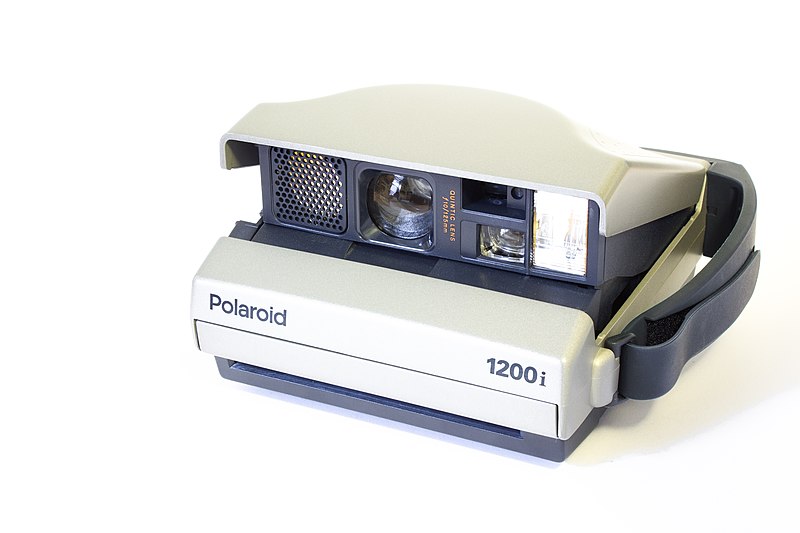My Polaroid Instant Cameras, 1969 – 2000

I have a bunch of still and movie film cameras I have collected over the years. The Polaroid ones I’m most fond of, and have recently purchased some modern SX-70 film for the Land Camera 1000s and Model 1. Here are some photos and descriptions of some of my Polaroid collection, with cameras from 1969 to 2000 showing the progression of the various instant film types they made available.
Polaroid Automatic Land Camera 320 (1969, 100 Series Packfilm)
The Automatic Land Camera 320, produced between 1969 and 1971, is a folding packfilm camera known for its simplicity, robust plastic build and reliability. It uses Polaroid’s Type 100 series peel-apart film (72 × 95mm image, also info here), which produces instant photographs with a distinctive border.

Polaroid Type 100 film, which includes various types of peel-apart film used in Polaroid Land Cameras like the 320, is no longer produced. Polaroid discontinued the production of Type 100 film in 2008. However, some third-party companies, like FujiFilm, produced compatible peel-apart films (FP-100C and FP-3000B) for a time, but these too have been discontinued.
The camera included a 114mm f/8.8 2-element plastic lens, providing decent image quality for general photography. The camera is equipped has an automatic exposure system that adjusts the shutter speed and aperture based on the lighting conditions, ranging from 1/1200 second to 10 seconds.
The 320 has a built-in rangefinder for focusing, and includes an integrated flash socket compatible with the Polaroid #268 flash, designed for use with flashcubes for indoor and low-light photography.
Powering the camera is a 3V battery (two AA batteries), necessary for operating the electronic shutter and exposure system. The one I have also has a set of instructions in reasonable condition.
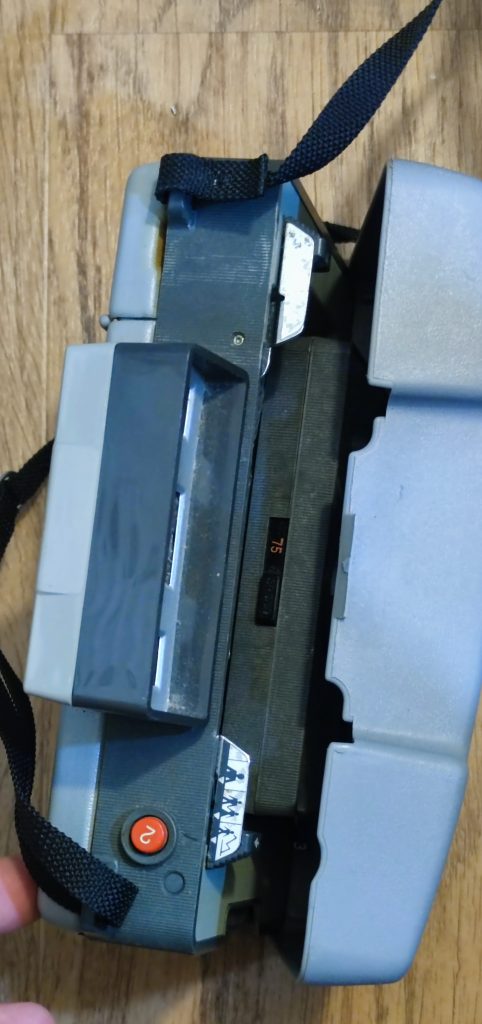
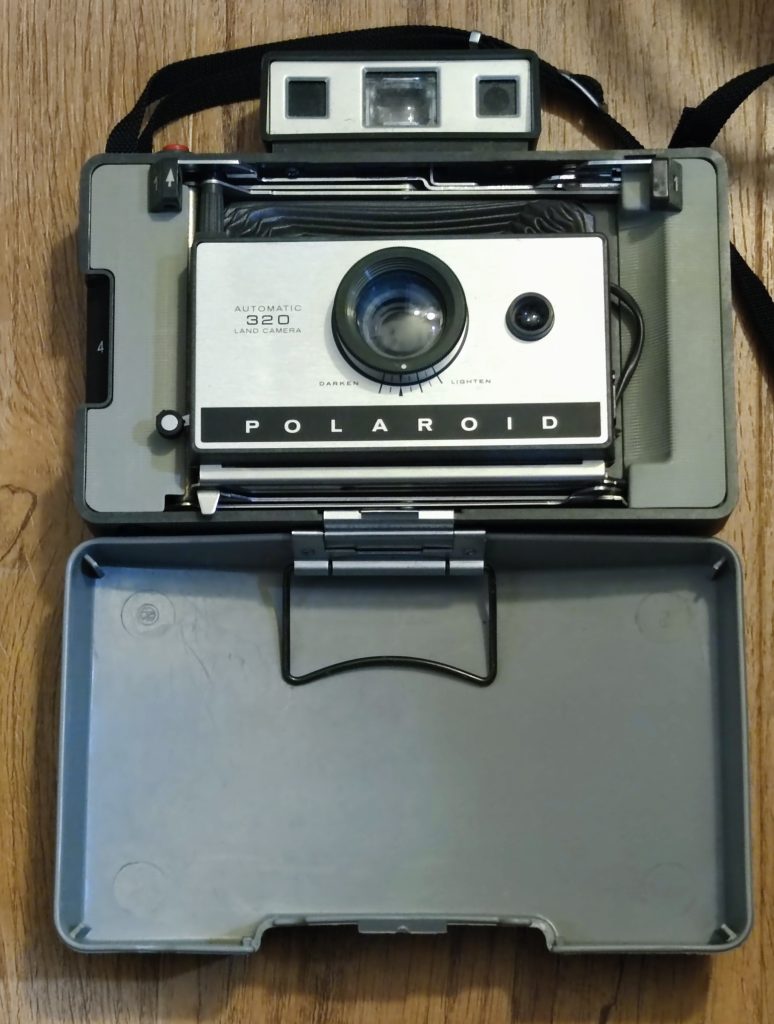
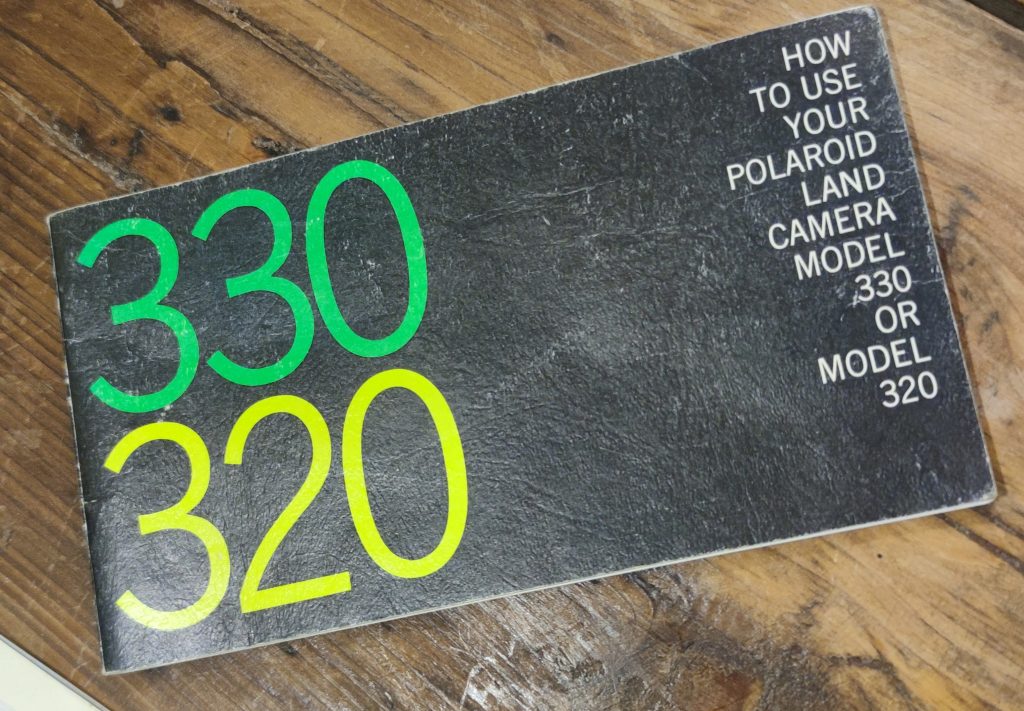
Various models of camera (including this one) came with a ‘cold clip’ for development (see photo below). The chemical reaction by which instant pictures are processed depends heavily on temperature. When it’s 30 degrees , color film develops in about one minute; at 10 degrees, it takes three times as long. When it’s really cold, it won’t work at all, which is where the Cold-Clip comes in. It is simply two sheets of aluminum (an excellent conductor of heat) that are hinged with a piece of tape. You are supposed to keep it in your pocket, prewarming it. When you pull your photo from the camera, you quickly tuck it inside the Cold-Clip, and, as the instructions say, “hold Cold-Clip between body and arm.” That’s right: Polaroid packfilm instructions involve shoving it into your armpit.
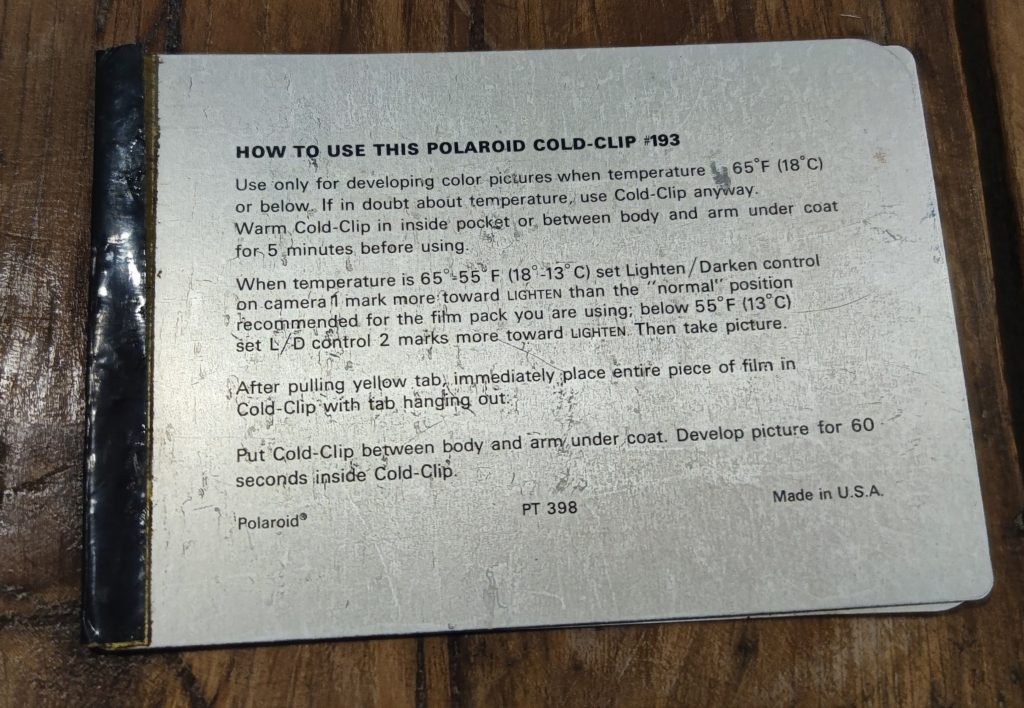
Polaroid Colourpack II (1970, 100 Series Packfilm)
The Polaroid Colorpack II is an instant film camera introduced in the late 1960s (1969-1972). It was the next iteration to use Polaroid’s Type 100 series instant print peel-apart film, and a move away from the folding bellows design.
It has a three-element, plastic, 114mm f/9.2 lens, a zone focusing system with a range from 3.5 feet to infinity, and automatic exposure system. Mechanical shutter speed is 1/1200 to 10 seconds.
The camera again supports an external flash unit (Polaroid #268 Flash), and requires two AA batteries to power the exposure system and electronic shutter (one of the last to use batteries in the camera, future models had the batteries in the film cartridge)
My Colourpack II as you can see came with a lovely shiny leather shoulder carry case, and the instructions/brochure.
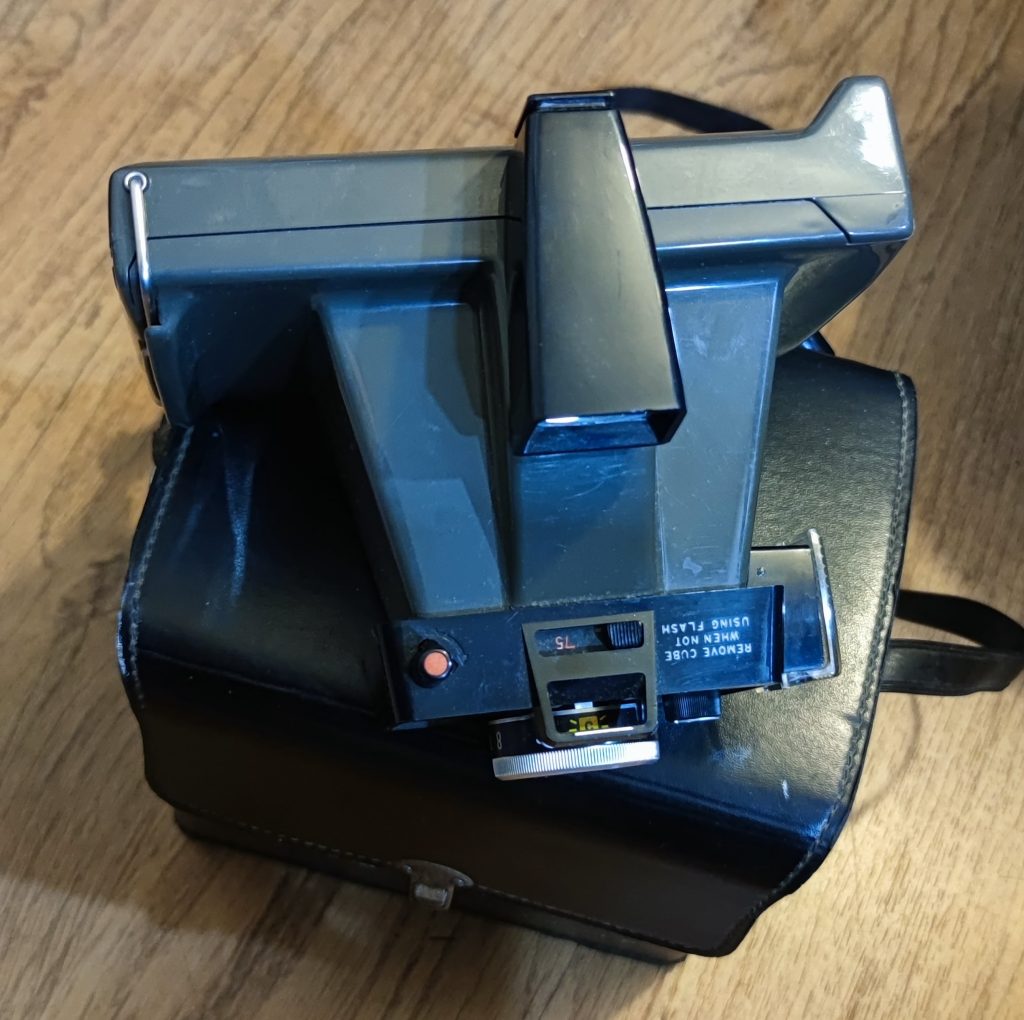
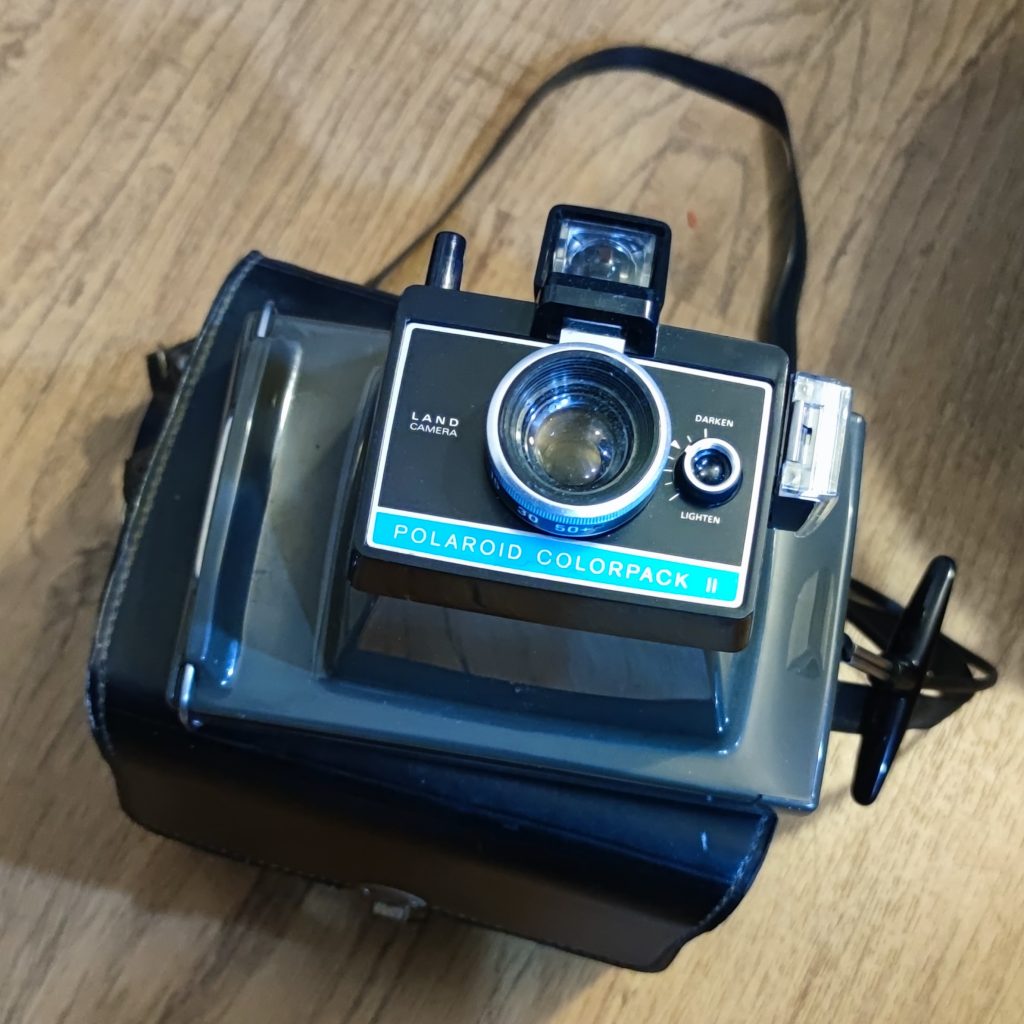
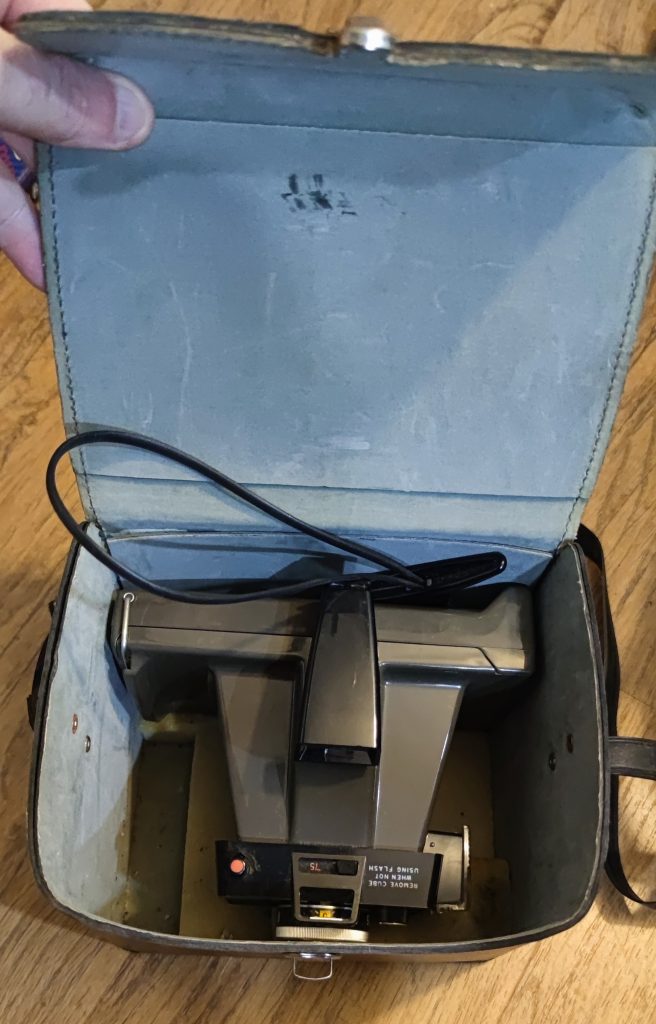
Polaroid Mini Portrait 202 (1970, 100 Series Packfilm)
This is an interesting camera produces around 1970 as it has two lenses, featuring a unique two-lens design, allowing it to capture two identical images on a single piece of Polaroid instant film. This design makes it particularly useful for generating two photos on a film, but more commonly multiple copies of small-format photos, such as those required for IDs and passports. There was also a 4 lens version.
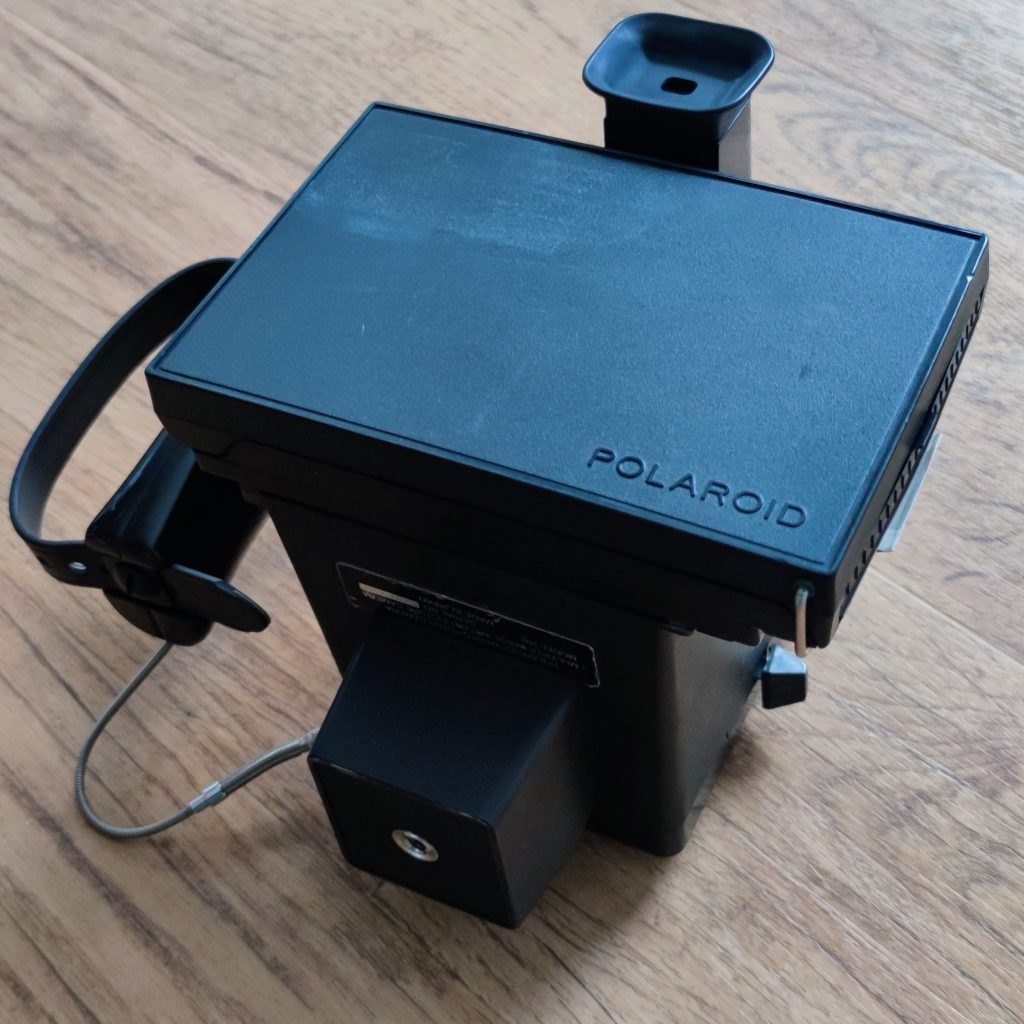
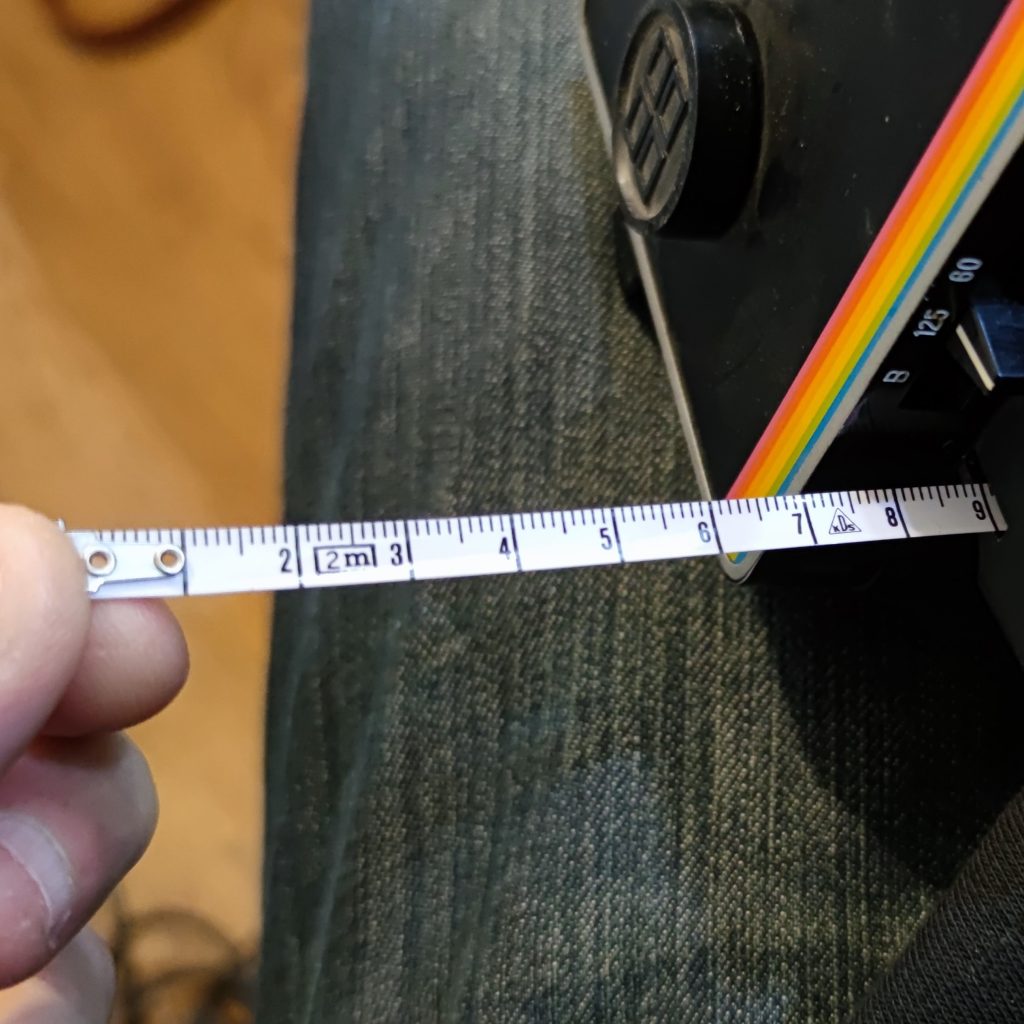
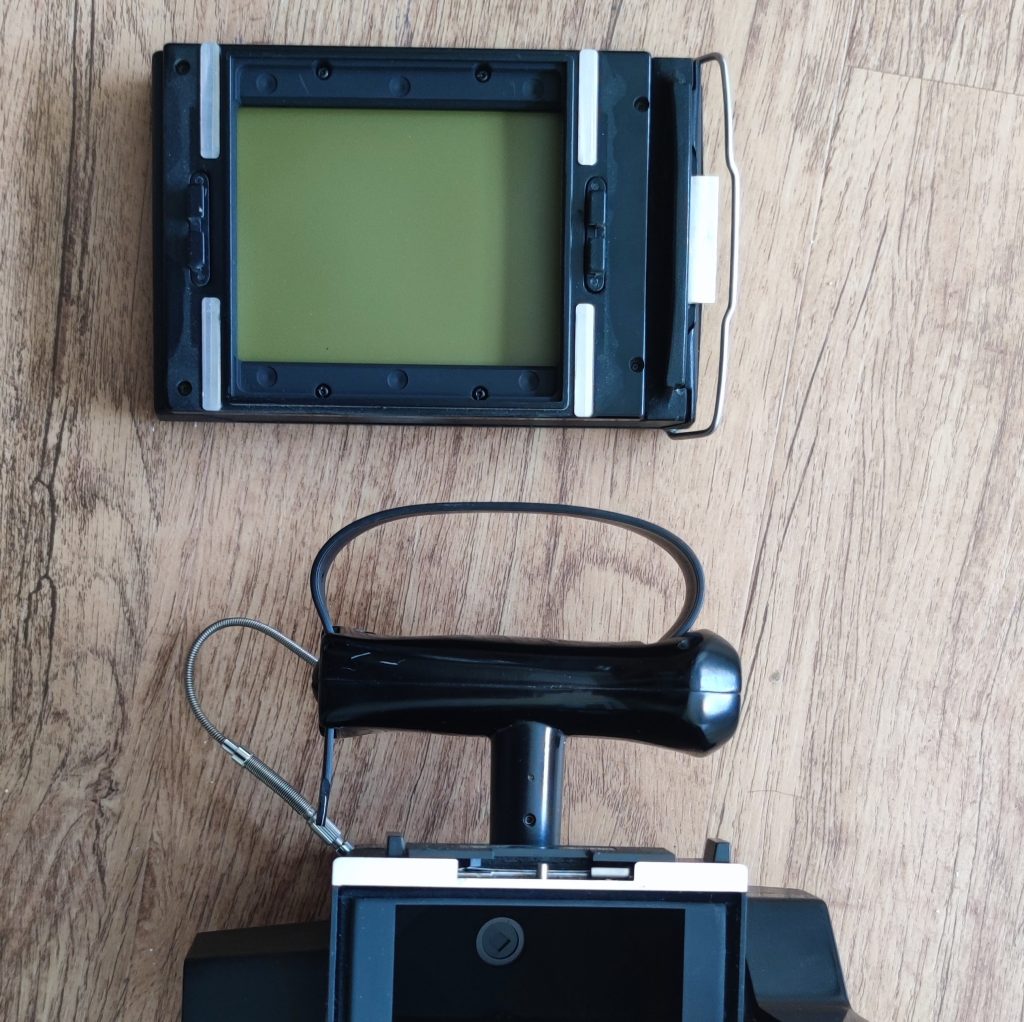
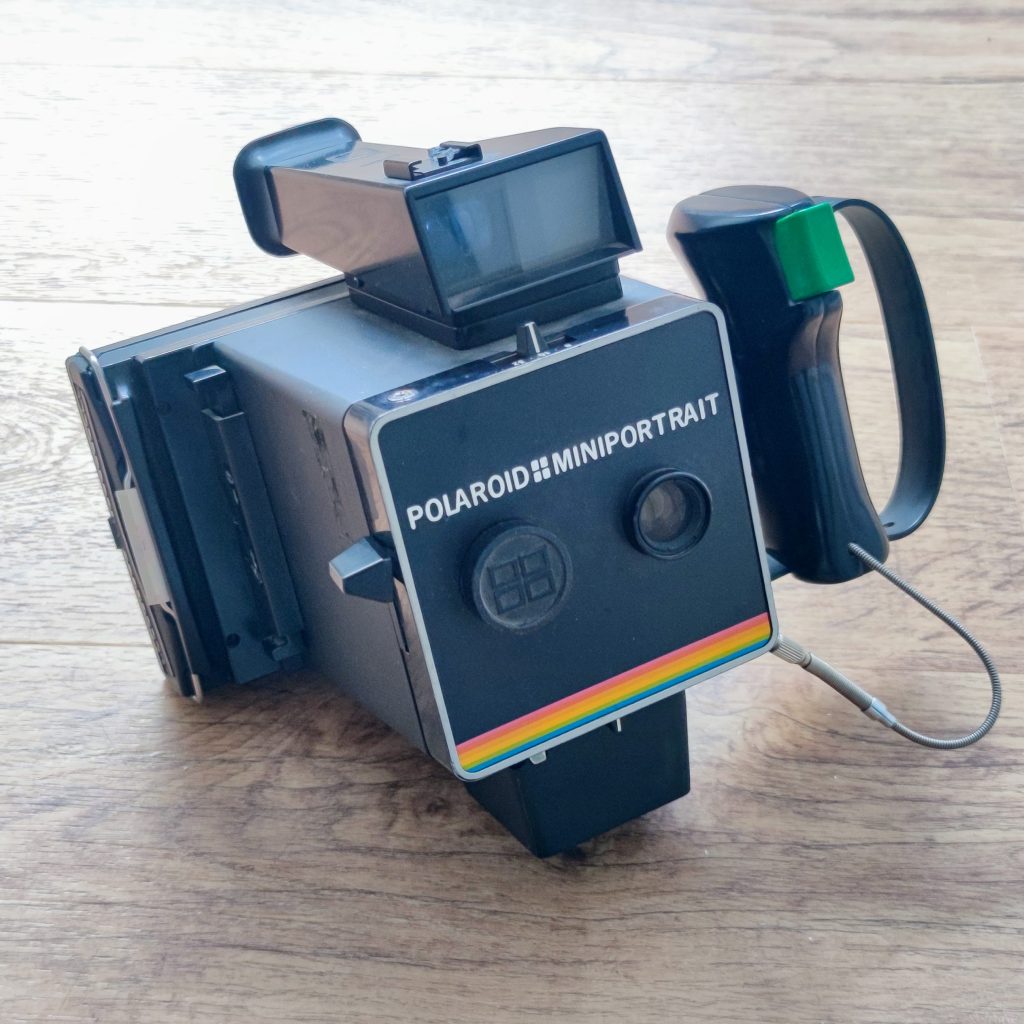
It has a fixed focus, and a handy ruler in the base mount to enable the subject to sit at exactly 1.2m. No batteries needed for these models, and has manual switch settings for shutter speeds of 125,60 (or Bulb), and a 5 point f-stop between 8 and 32.
Possibilities of still using this with a replacement film back exist (eg instax wide), but they are not particularly cheap for the back.
Polaroid Colorpack 80 (1971, 80 Series Packfilm)
Produced from 1971-76, the 80 used the slightly smaller Type 80 peel apart film (69 × 72mm image). It went to a fixed-focus, single-element plastic lens that simplifies the shooting process by eliminating the need for manual focusing. No batteries were now required for operation, and a external flash unit was required for low-light photography. It has a basic automatic exposure system, with exposure control dial on the front.
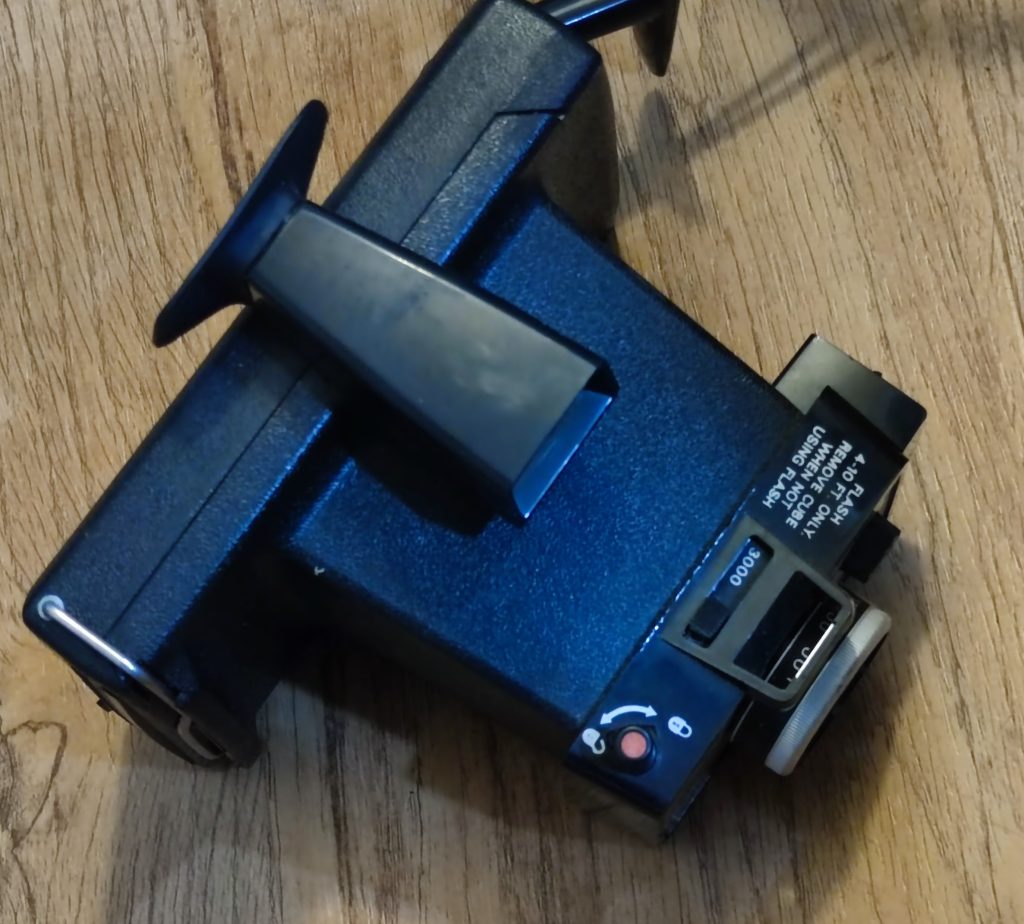
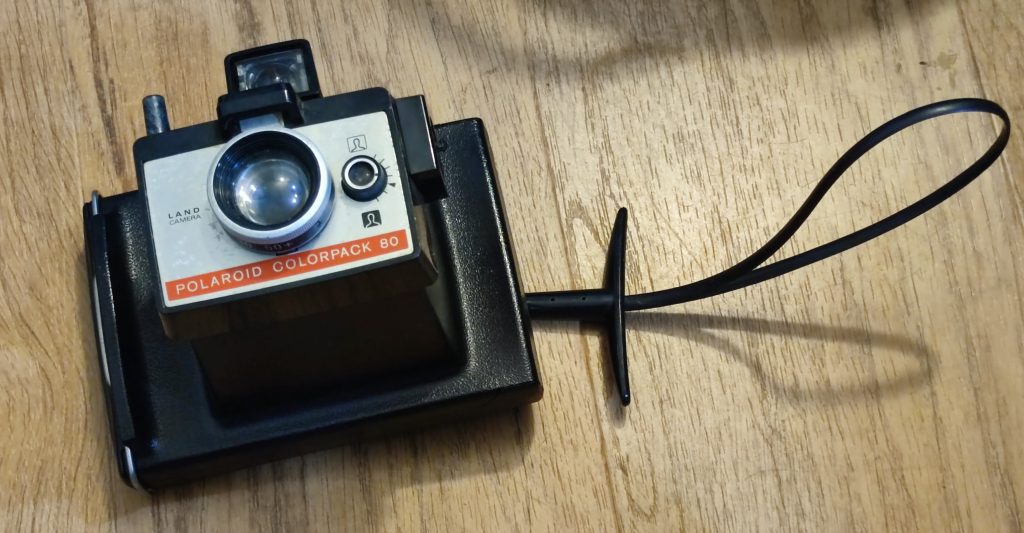
Polaroid Zip (1974, 80 Series Packfilm)
Produced from 1974-77, the Zip was another iteration in the Type 80 camera lineup. Slightly less bulky than the Colourpack, it also has a simpler exposure mechanism, with limited or no automatic exposure control, relying more on manual adjustment for proper exposure.
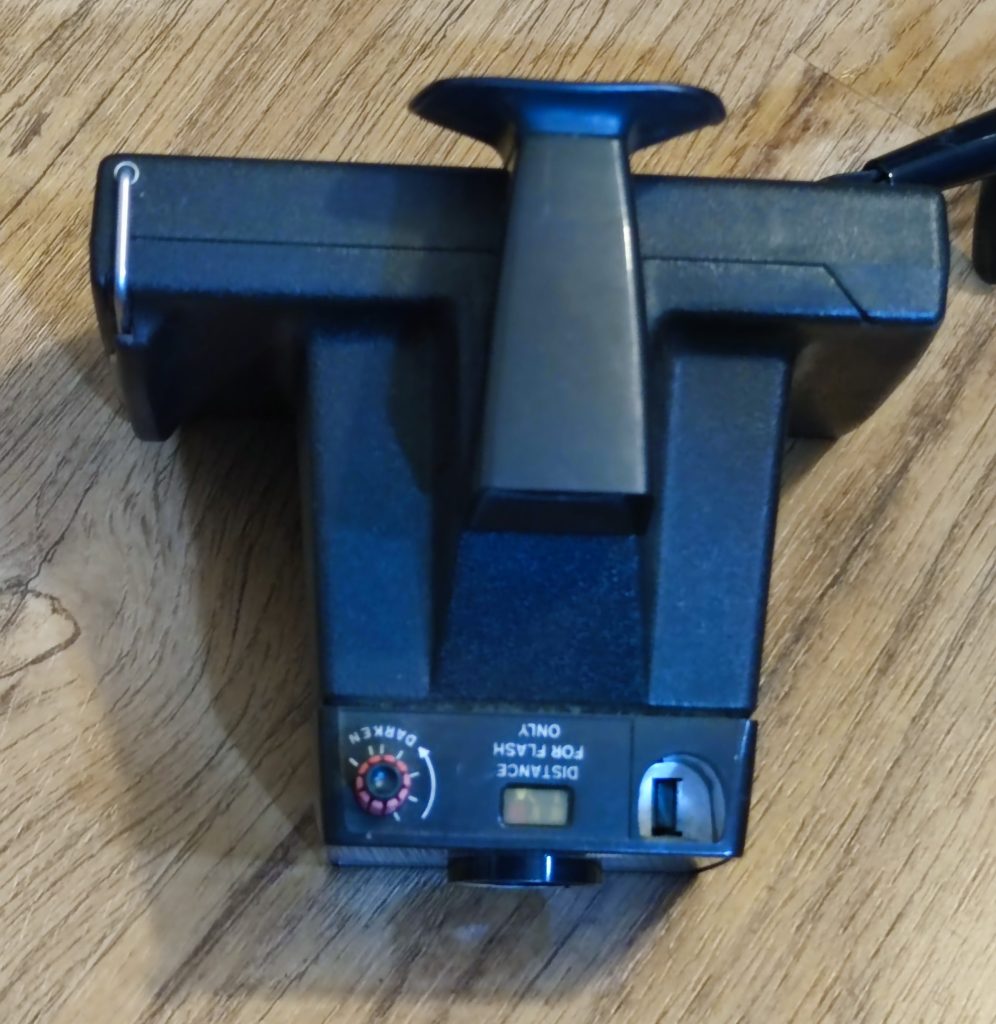
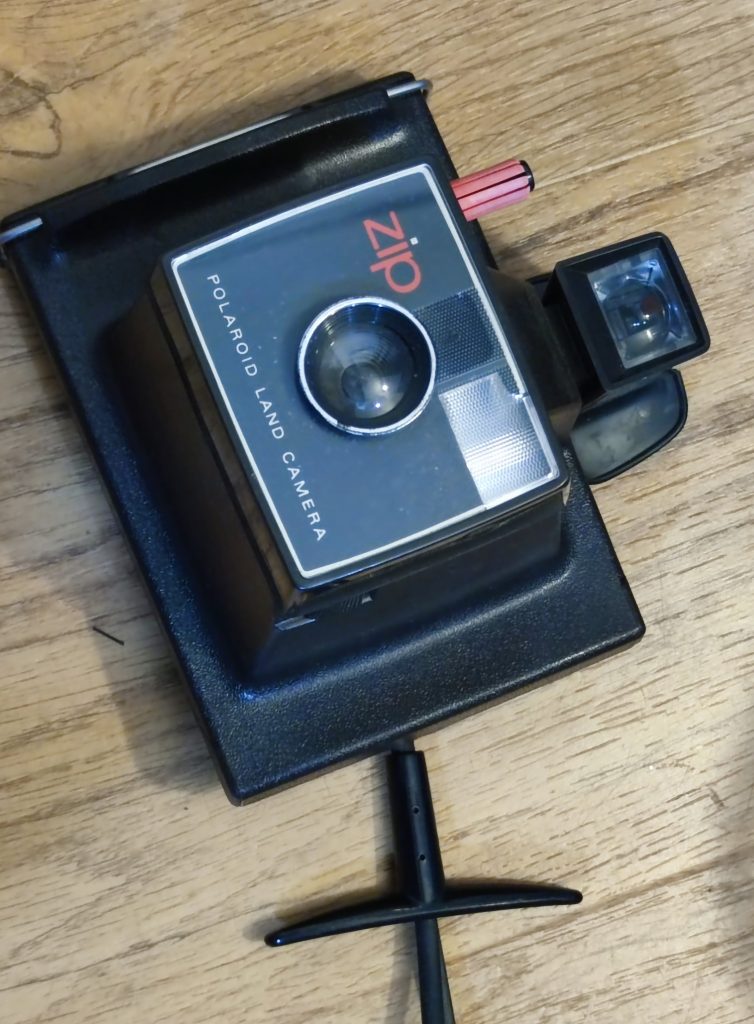
Polaroid SX-70 (1972, SX-70 Film)
The SX-70 was iconic and revolutionary. This camera (their first true SLR) folded into 25mm thick book sized device, and SX-70 film ejected automatically and developed quickly (fully within 10 minutes) without chemical residue. Polaroid founder Edwin H. Land announced the SX-70 at a company annual meeting in April 1972.
It was not cheap at $180 on release (over $1000 in 2024 money), but is in my opinion the most elegant model produced. The model 1 is a beautiful piece of engineering as well as industrial design.
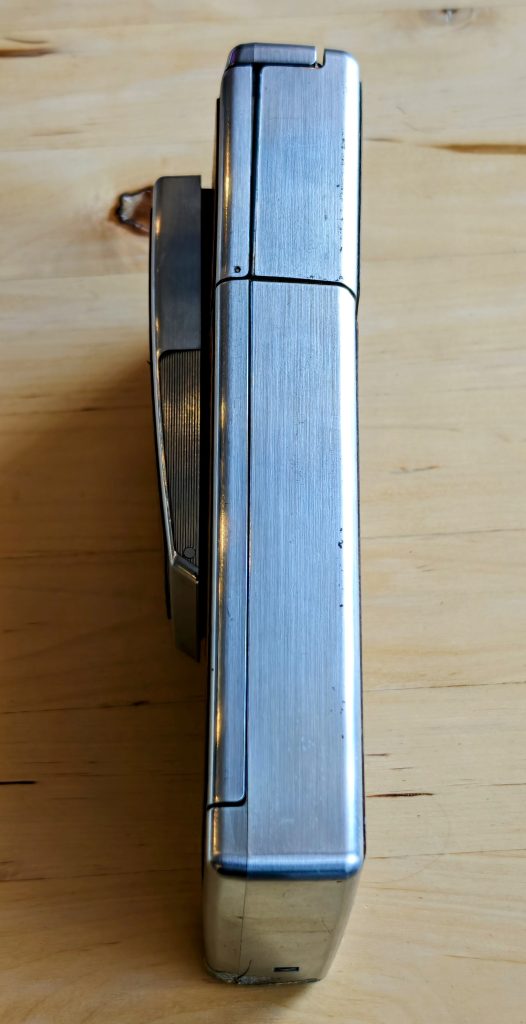
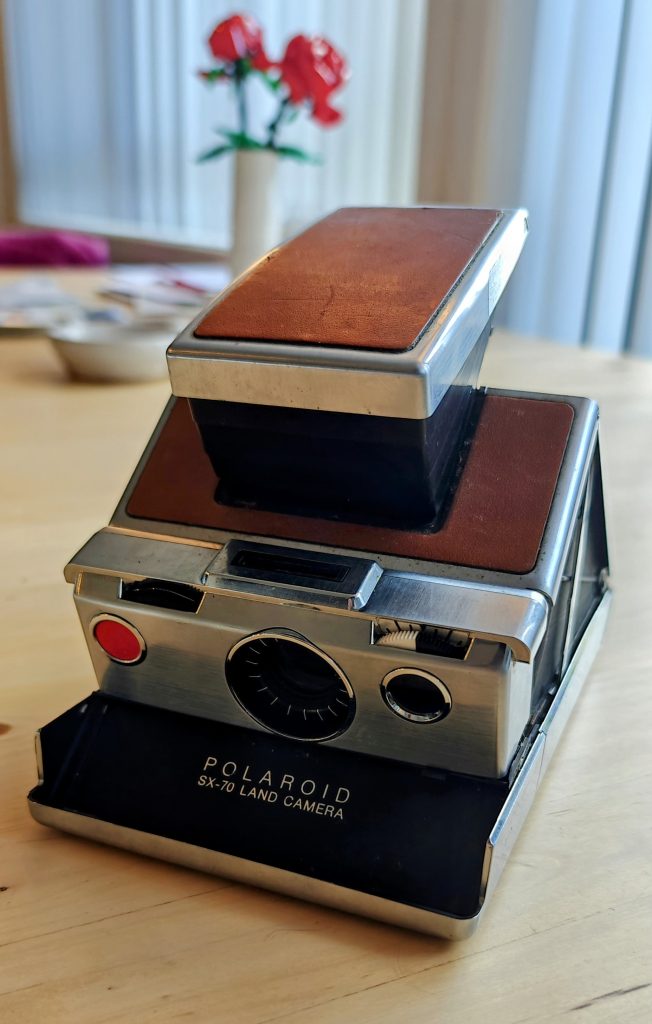
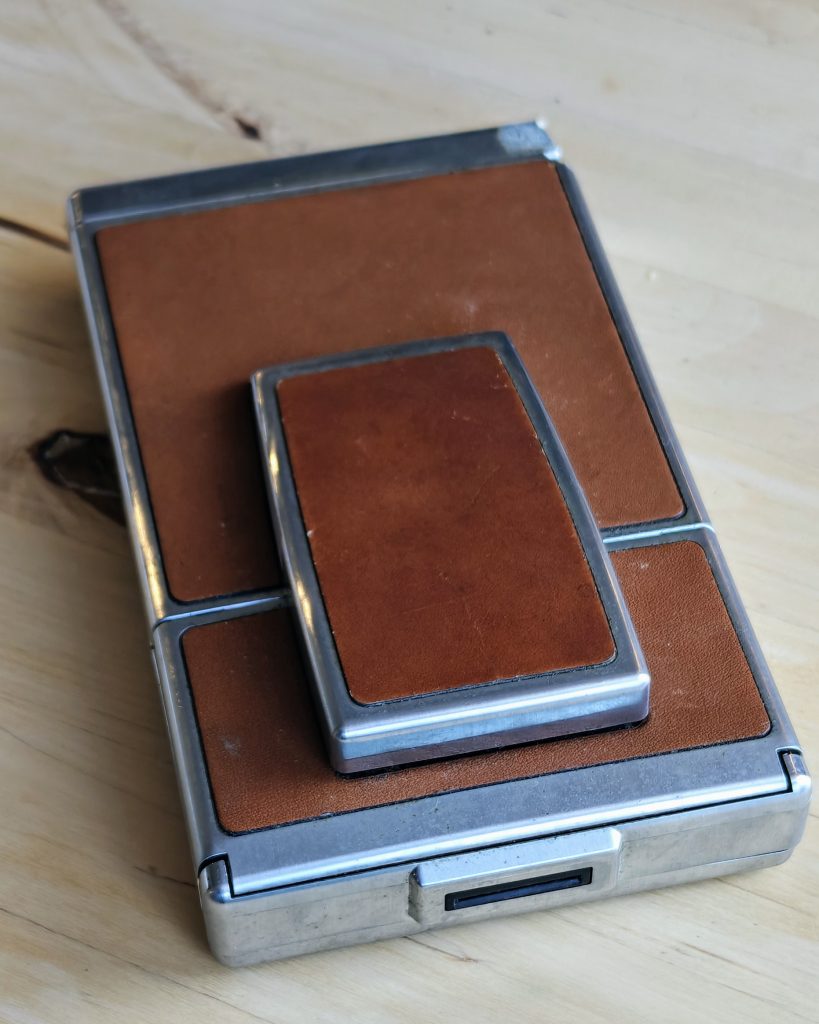
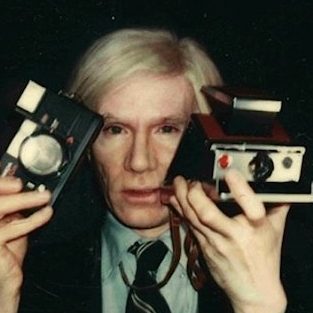
He is also holding a 35mm Konica C35EF (on the left)
Polaroid Land Camera 1000 (1977, SX-70 Film)
The Polaroid 1000 Land Camera was introduced in the 1977 as a cheaper but less compact version of the SX-70. Manufactured up to the early 1980s, it also used SX-70 film (also here) to produce square-format instant photographs, which (as of 2024) is still available to purchase locally or from 3rd party manufacturers such as Impossible (Now, rebranded as Polaroid, see below photo for my recent Colour SX-70 Film purchase)
The Land Camera 1000 (marketed as the OneStep in the US) is probably the most iconic Polaroid design, and (fun fact) came with either a red or green shutter button. This is definitely the favourite of my lot, and I’ve got a few.
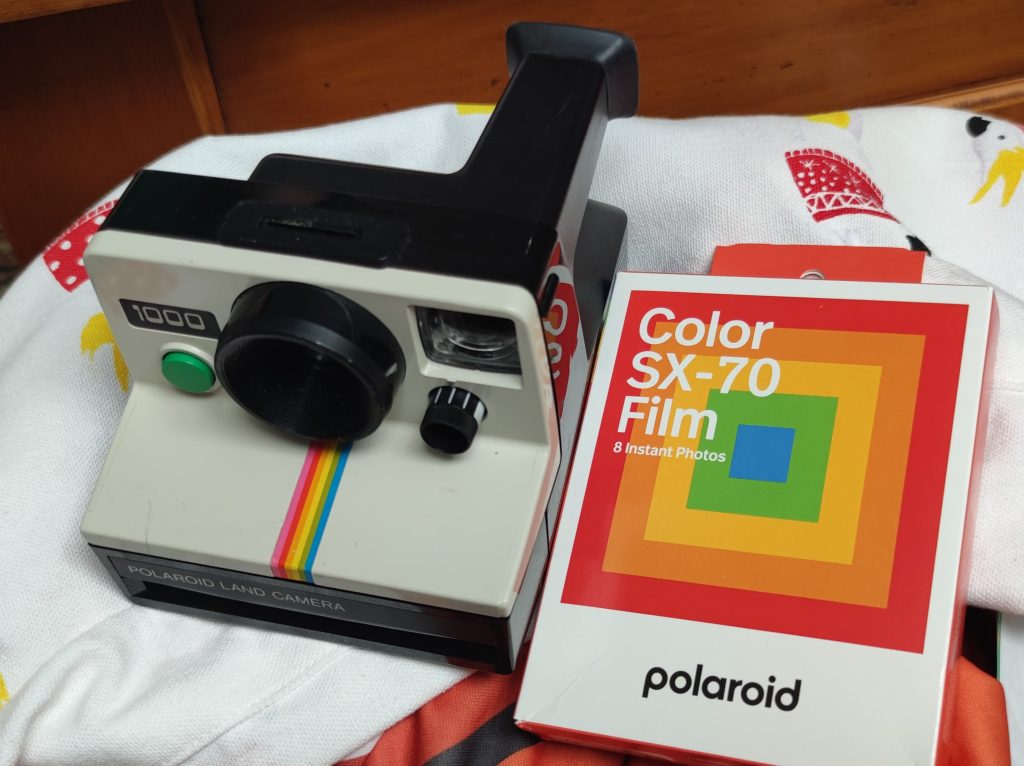
With a release price of just $40 (~US$200 in 2024), the Land Camera 1000 became the best-selling camera of the 1977 Christmas shopping season. Later, Polaroid released Type 600 integral series cameras, utilising the same film format and cartridge but with a different film formulation.
The 1000 is equipped with a 103mm f/14.6 fixed-focus lens, suitable for general photography and features an electronically controlled shutter with speeds ranging from 1/4 second to 1/200 second. It includes a Light Management System (LMS) for automatic exposure control, along with a built-in exposure compensation dial on the front for adjusting brightness.
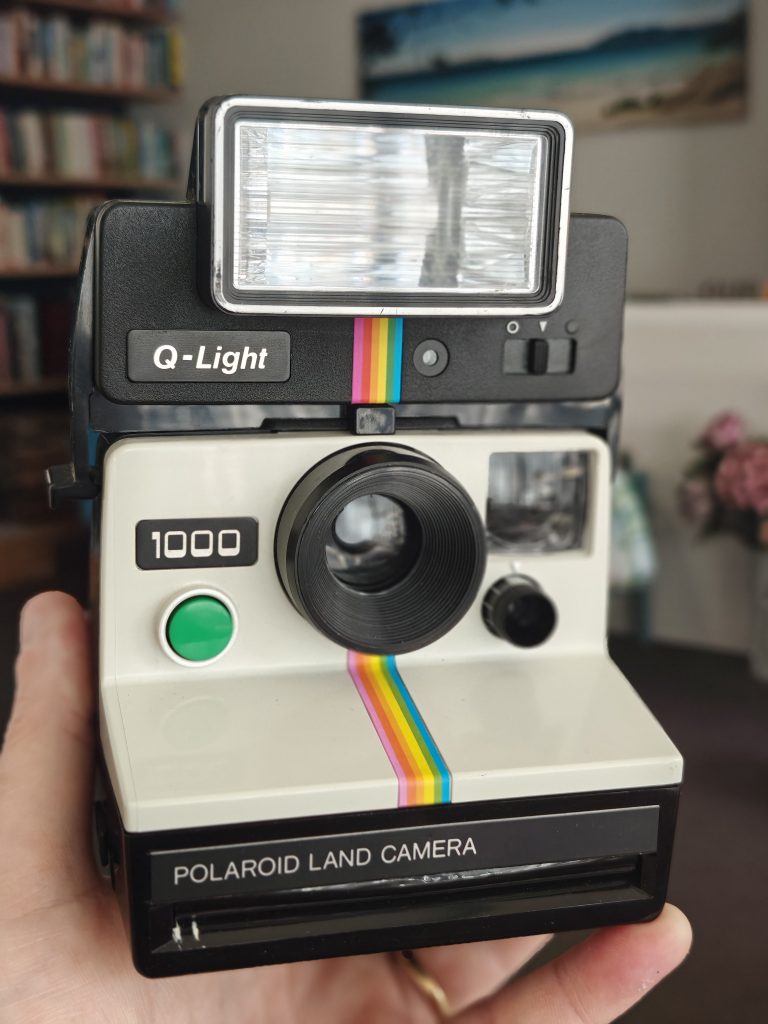
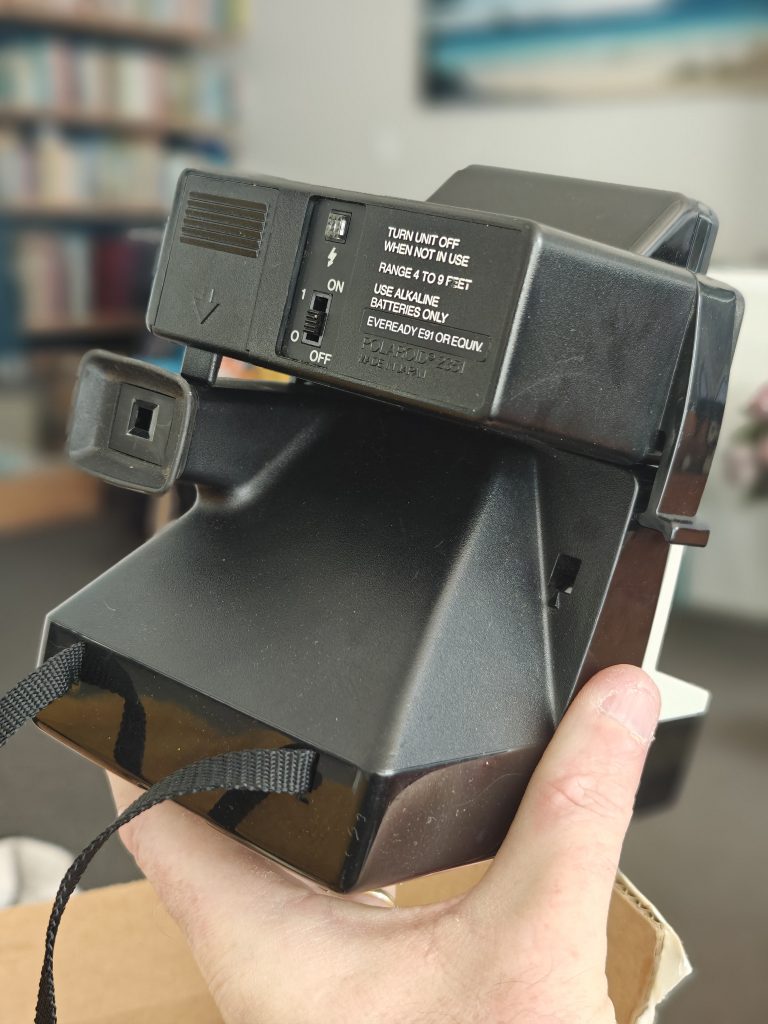
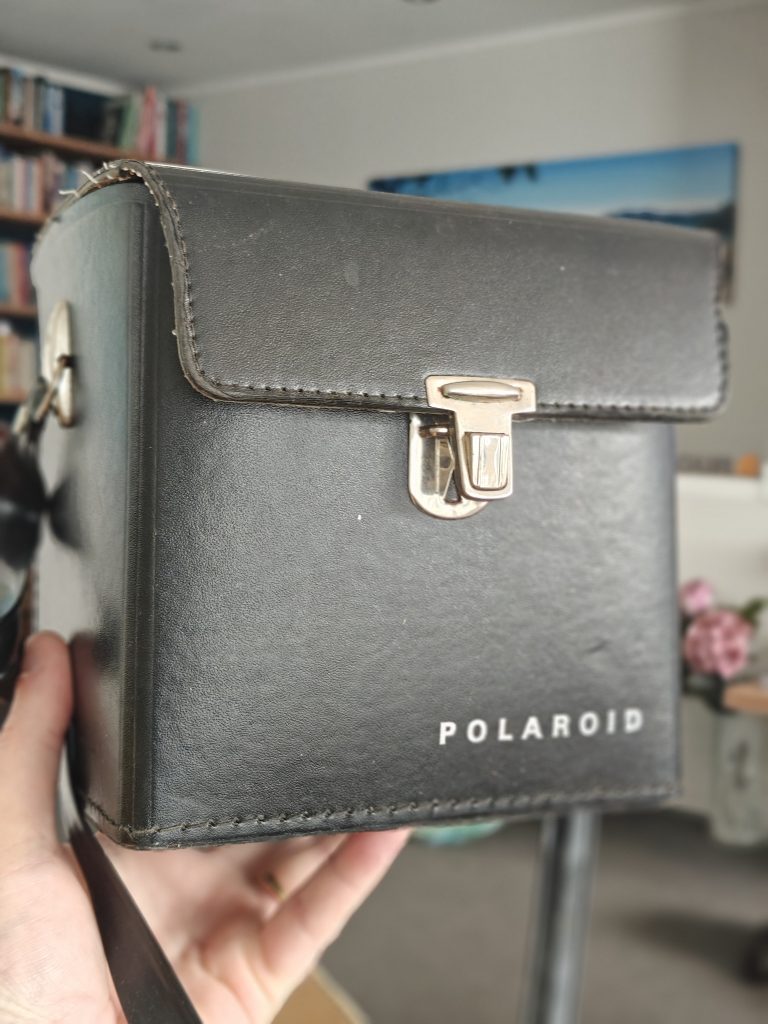
The viewfinder is a simple optical design for framing shots. For low-light photography, the camera is compatible with an external flash unit (Q-Light Flashbar) that attaches to the top of the camera (see my Q-Light in the photo above, along with the neat leather case for the two together). The power source is a battery integrated into the film pack and it produces instant photographs with the characteristic Polaroid SX-70 look/size.
Polaroid Onestep 600 (1981, 600 Series Film)
The design of the 600 is still characterized by the iconic rainbow stripe on the front, which has become synonymous with Polaroid’s branding, but with a black case in an iteration back to the earlier land cameras. It is still a simple fixed focused point and shoot (with no other controls) and was manufactured right up until the early 1990s along with others in the 600 series.
The OneStep 600 is powered by a battery included in each 600 series film cartridge, and it does appear that as of 2024, you can buy new 600 film.
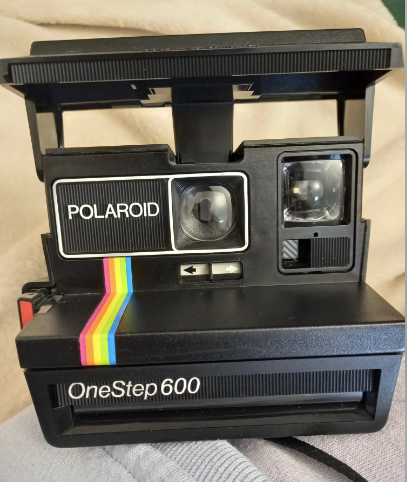
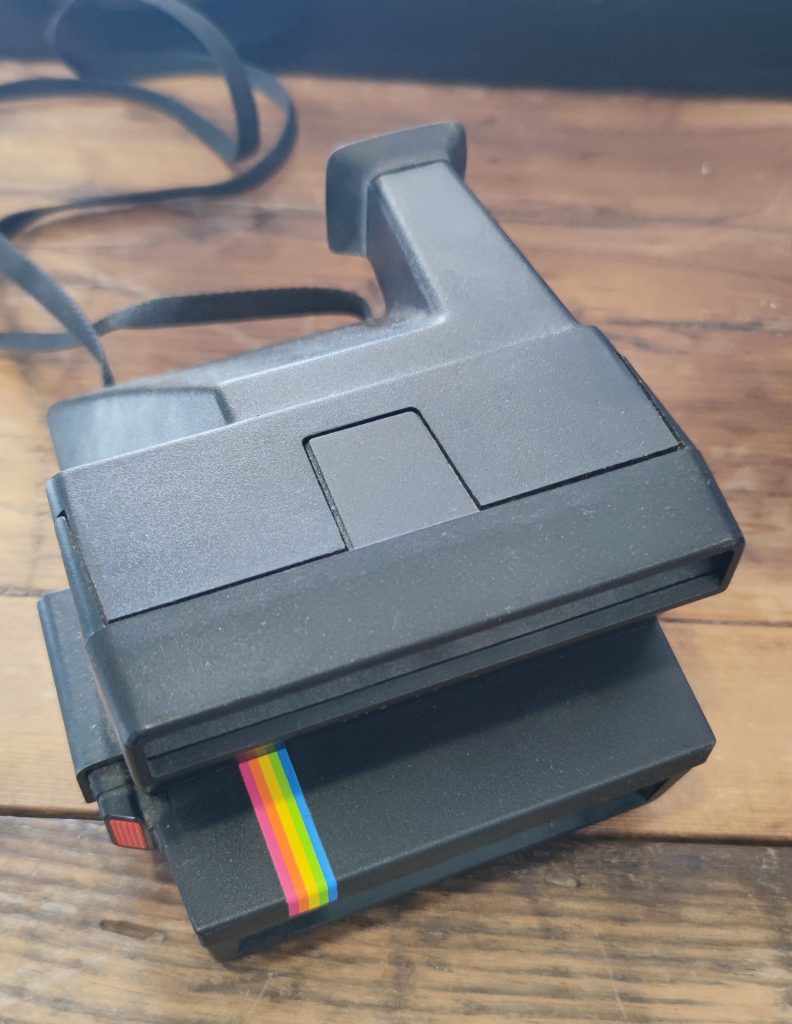
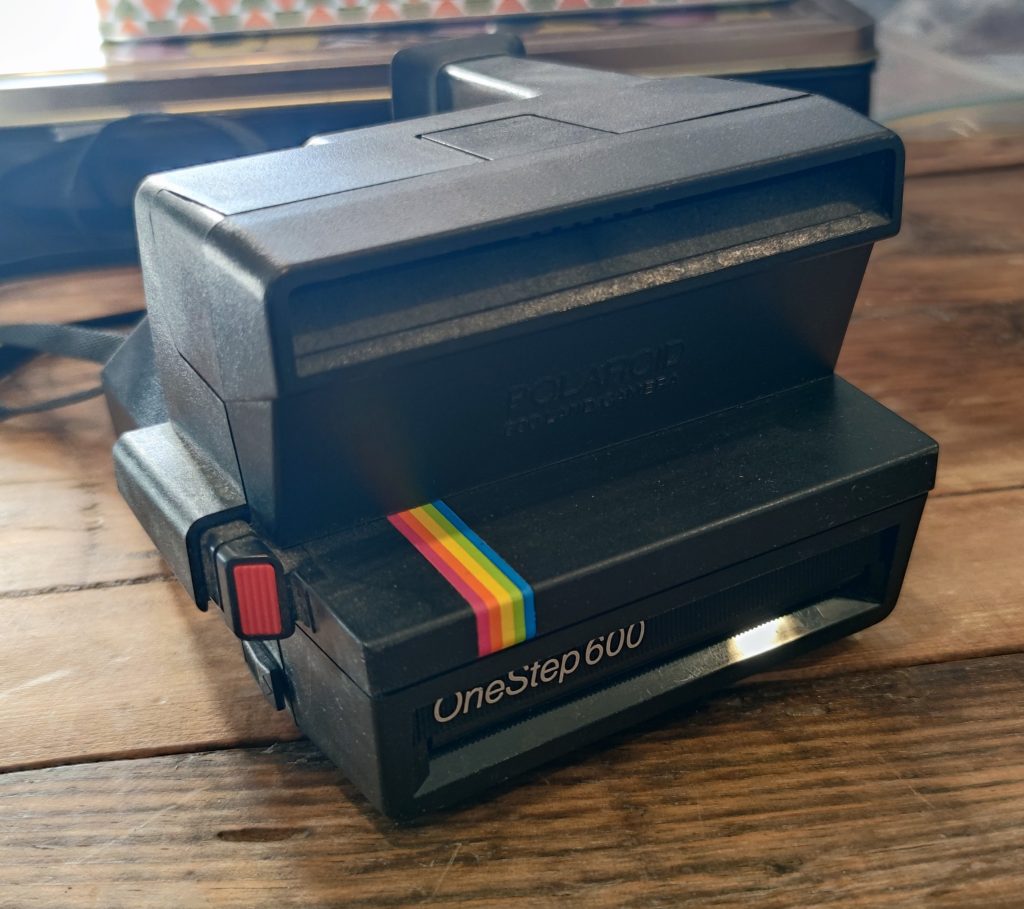
Polaroid Joycam (1999, 500 Film)
The Polaroid Joycam, introduced in the late 1990s, uses Polaroid 500 film cartridges which are similar to the Instax mini size from FujiFilm (see notes below) The camera itself came in a dark grey, silver and blue (as per this one). From the pics you can see the bag it came with and some simple instructions printed on the base. I still also have an 500 instant film cartridge, but it is well expired (20 years ago!). Each film cartridge contains 10 sheets, and again includes a battery that powers the camera’s motor and flash. As at 2024, 500 film is unavailable.
The Joycam is obviously bigger than the point and shoot film cameras of the era, but is easy to use. The fixed-focus lens is simple, but the integrated flash helps in low-light conditions. It was the budget-conscious plastic Polaroid of the time.
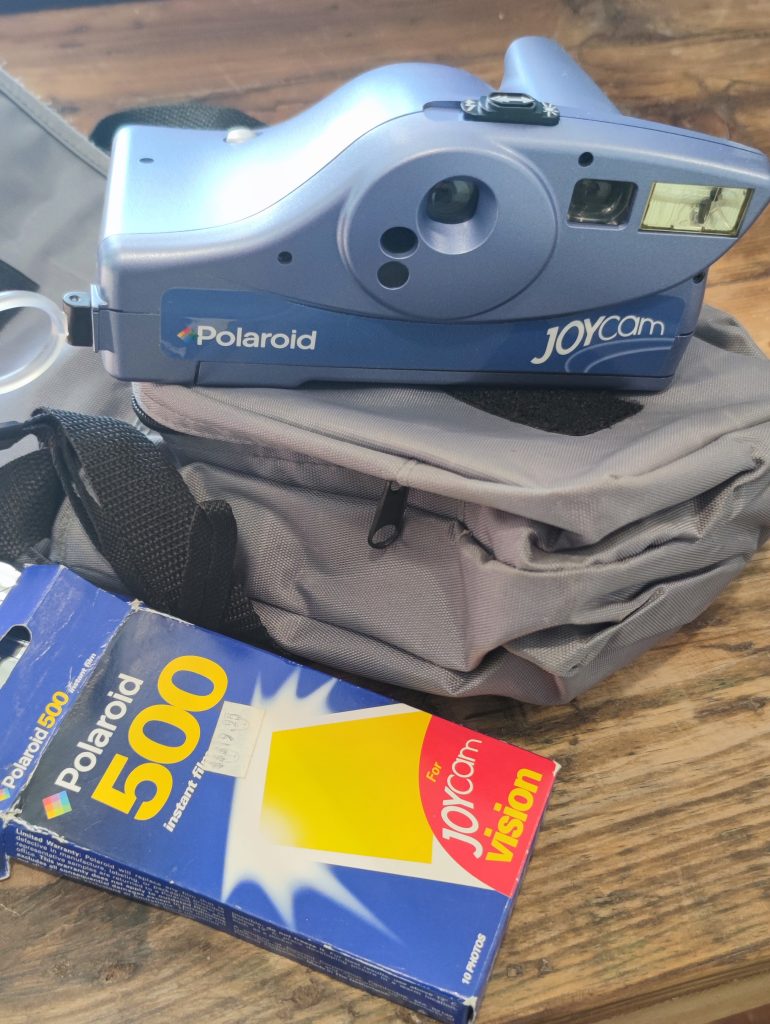
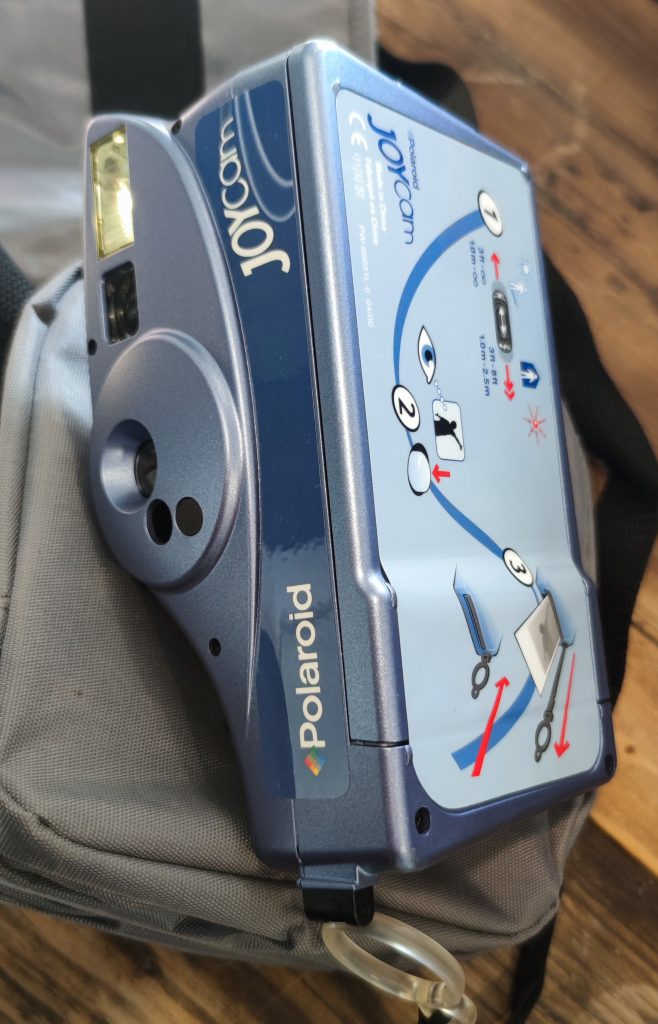
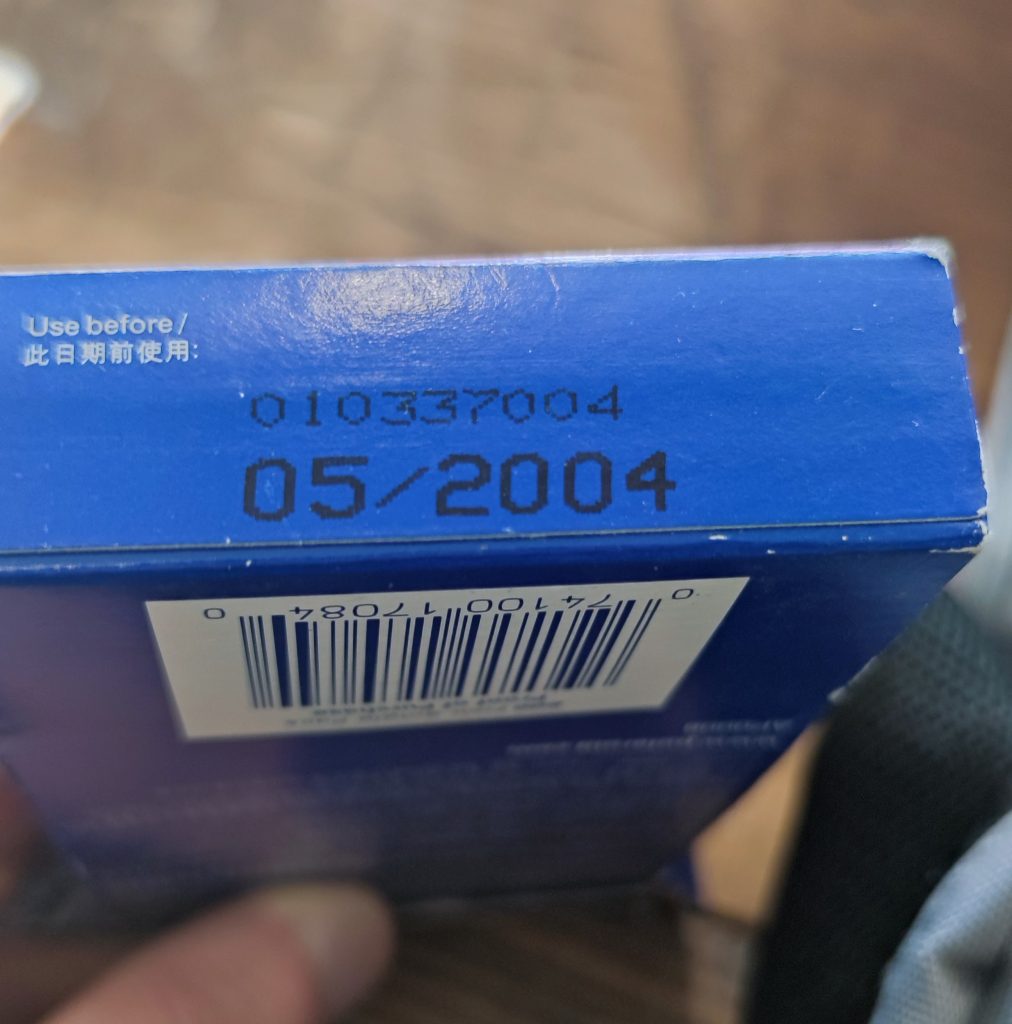
Polaroid 1200i (2000)
This camera, in a lovely beige/grey used the larger 1200 or “Spectra” film, which has an image area of 73 × 91 mm2 and a total area of 103 × 102 mm2. It folds into a compact format and the lens/flash can pop up when needed. This film is no longer available.
It features a 3-element, 95mm lens with an aperture of f/14.6, auto exposure system and and an autofocus with a range of 0.6 meters to infinity. It also has an integrated electronic flash for low-light situations, with automatic activation and a flash override option.
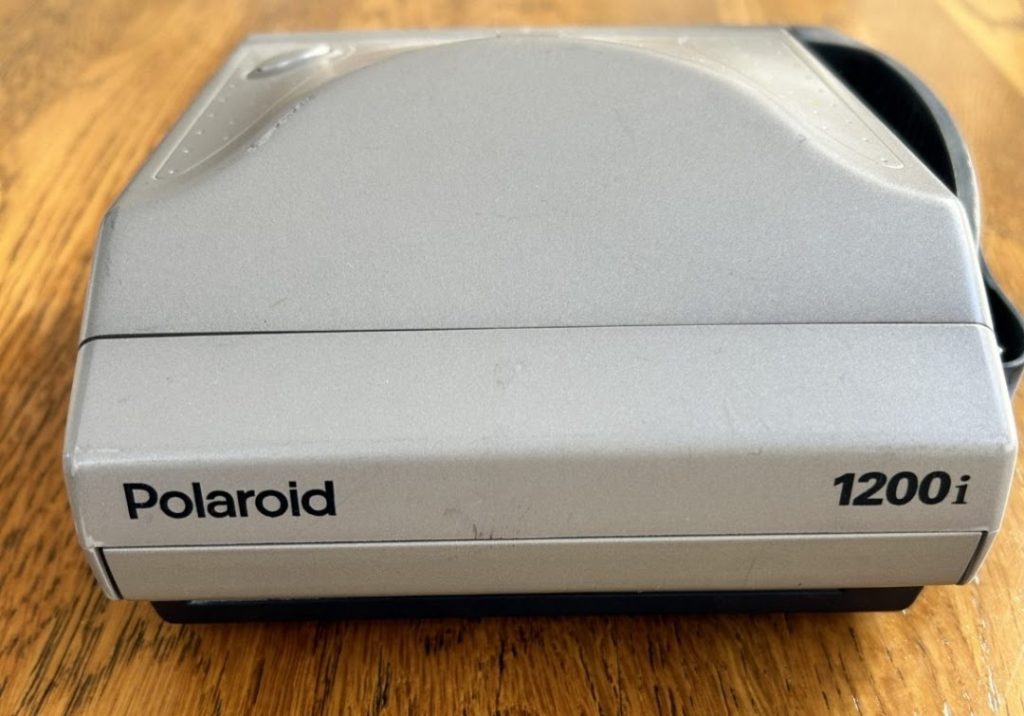
The Fall, and Revival of Polaroid
Polaroid stopped producing instant cameras altogether in 2007. This decision came after the rise of digital photography, which significantly reduced the demand for instant film. Following the discontinuation of their instant cameras, Polaroid also stopped producing instant film in 2008. However, in the years after, the brand was revived by enthusiasts, leading to the reintroduction of Polaroid cameras under the Impossible Project (later rebranded as Polaroid in 2020). This marked the return of new instant cameras like the Polaroid Now and OneStep+ starting in the late 2010s.
FujiFilm Instax Instant cameras (1998)
The Fujifilm Instax line of instant cameras was first released in 1998. Unrelated to Polaroid, and using their own instant film technology, Fujifilm’s Instax cameras somewhat filled the void left by Polaroid’s decline during that time. The Instax Mini series was released first in Japan, aiming to capture the nostalgia and popularity of instant photography. Instax cameras produce smaller credit-card-sized prints (similar in size to the discontinued Polaroid 500), and the film format has remained a popular choice for instant photography enthusiasts around the world.
Over the years, Fujifilm has expanded the Instax lineup with different models, with the Instax Mini range expanding to Instax Wide, and Instax Square formats. I have an Instax Square printer (which is rechargeable, takes a 10 pack of square film and prints from my phone) and that film is approximately 35% smaller area compared to a Polaroid i-Type or 600 print.
i-Type Film and Modern Onestep 2 (2017)
Polaroid i-Type film was introduced in 2017 as part of Polaroid’s revival of instant photography, coinciding with the release of new instant cameras like the Polaroid OneStep 2. It was created to work specifically with modern Polaroid cameras, which have built-in rechargeable batteries, eliminating the need for a battery in the film pack itself. This makes i-Type film more sustainable and affordable than older formats like Polaroid 600 film.
By releasing i-Type film, Polaroid aimed to reintroduce instant photography to a new generation while maintaining the nostalgic aesthetic of its earlier products. The film provides the same high-quality colour saturation and sharpness as earlier models, but with advancements suited to modern users. It’s available in both colour and black & white versions, with occasional limited editions that feature special borders or effects.
The i-Type film itself is identical chemistry and size to the 600 and maintains the classic Polaroid look with its square image and white border. You cannot use i-Type film in a 600 camera unfortunately, but you can use 600 film (which still comes in a few varieties) in the newer cameras (the camera just bypasses the battery in the film pack).
Polaroid Go (2021)
The Polaroid Go, released in 2021, is Polaroid’s smallest instant camera, designed to offer a portable and compact version of the classic instant photography experience. It uses a unique smaller film format exclusive to the Go which comes in packs of eight photos, available in both color and black & white. The Go produces 66.6 x 53.9 mm photos (slightly smaller than Instax Mini), with the image area itself being 47 x 46 mm. Like other modern i-Type Polaroid models, the Go camera features a built-in rechargeable battery, so the film packs do not need individual batteries. The prints retain the iconic Polaroid white border, but in a much smaller size, perfect for easy portability.

